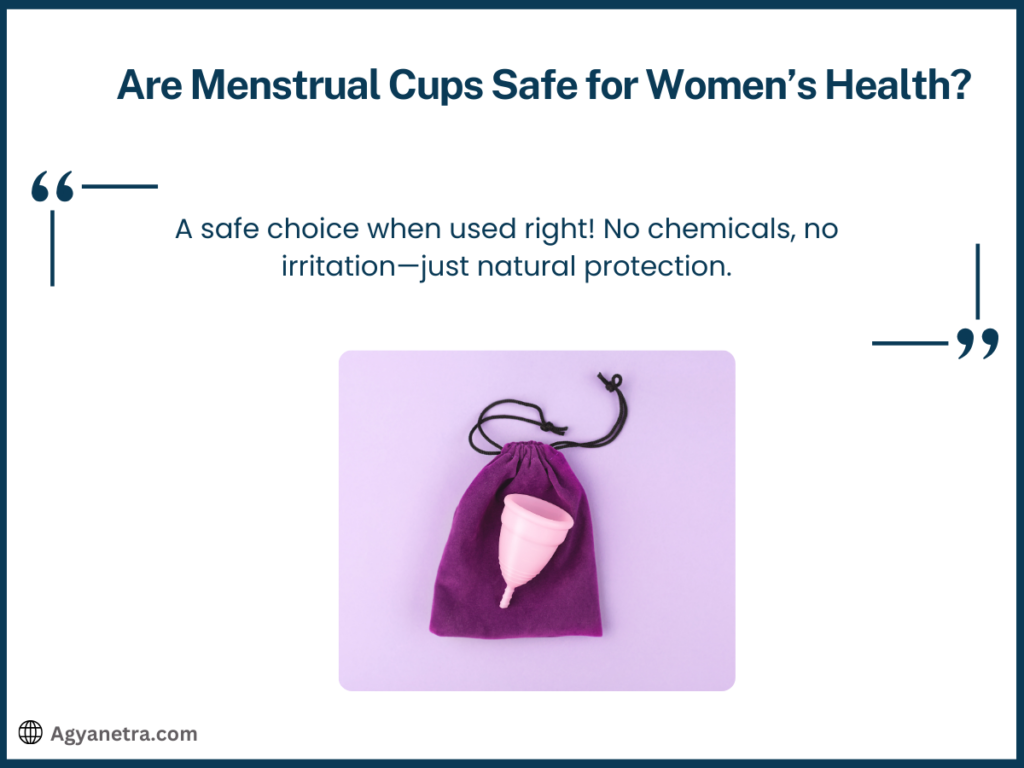Are Menstrual Cups a Better Choice for Women’s Health? If you’ve ever wondered whether menstrual cups are safer, more comfortable, or better than pads and tampons, you’re not alone. Many women are now making the switch, but is it the right choice for you?
Menstrual cups promise leak-free protection, eco-friendliness, and long-term savings—but are they really as good as they sound?
In this guide, we’ll explore everything you need to know about menstrual cups—how they work, their benefits, possible drawbacks, and whether they truly make periods easier.
By the end, you’ll have a clear answer on whether menstrual cups are the right fit for your lifestyle and health. Keep reading to discover the truth about this rising period care alternative!
What Are Menstrual Cups and How Do They Work?
Menstrual cups, also called period cups, are reusable feminine hygiene products designed to collect menstrual blood instead of absorbing it like pads or tampons.
Made from medical-grade silicone, rubber, or TPE (thermoplastic elastomer), these small, flexible cups are inserted into the vagina, where they form a seal against the vaginal walls to prevent leaks.

Unlike disposable sanitary products, menstrual cups can be used for up to 8–12 hours, depending on the flow, making them a cost-effective and eco-friendly option.
Many women are now switching to menstrual cups for their comfort, convenience, and sustainability.
A Brief History of Menstrual Cups
The idea of menstrual cups is not new. The first version, called ‘The Hockert Catamenial Sack,’ was introduced in 1867 in the United States. However, it was not commercially viable.
In 1937, an American actress, Leona Chalmers, patented and introduced the first reusable menstrual cup.
These cups were made of latex rubber and had a bell-shaped design. Unfortunately, their popularity declined during World War II due to a rubber shortage.
In the 1960s, Chalmers made another attempt to bring them back, but many women found the product uncomfortable and difficult to use.
Fast forward to the 2000s, the introduction of medical-grade silicone menstrual cups changed the game.
In 2002, the Mooncup became the first widely accepted silicone menstrual cup, offering a hypoallergenic and latex-free alternative.
Today, with growing awareness of sustainable menstrual hygiene, more women are choosing menstrual cups over traditional disposable products.
Types, Sizes, and Shapes of Menstrual Cups
Choosing the right menstrual cup can be tricky as they come in different sizes, shapes, and designs. Selecting the perfect fit depends on factors like age, flow intensity, and whether you’ve given birth vaginally.
Menstrual cups are available in V-shaped, bell-shaped, round, or asymmetrical designs. V-shaped cups are the most popular because they are easy to insert and remove.
They also come in various sizes like teen size, small, large, and extra-large. Most brands offer a size guide based on flow and age. Some cups come with a grip stem for easy removal, while others are stemless. The choice depends on personal preference.
How to Insert a Menstrual Cup Easily
Switching to a menstrual cup for the first time can feel overwhelming. However, with a bit of practice, it becomes second nature. Here’s how to insert it properly:
Start by washing your hands thoroughly with mild soap and water. Next, choose a comfortable position—sitting, squatting, or raising one leg can make insertion easier. Before inserting the cup, fold it into a smaller shape.
Some common folding techniques include the C-Fold, 7-Fold, and Punch-Down Fold. Once folded, gently slide the cup into the vagina at a 45-degree angle toward the tailbone.
After insertion, the cup should open up and create a seal against the vaginal walls. If you feel discomfort, it means the cup has not fully opened—try rotating it slightly to ensure a proper seal.
How to Remove a Menstrual Cup Without Discomfort
Removing a menstrual cup is just as important as inserting it correctly. Many first-time users worry about the process, but following the right steps makes it easy and painless.

First, wash your hands to prevent infections. Find a comfortable position, just like when inserting the cup.
Relax your pelvic muscles, as tension can make removal difficult. Insert your thumb and index finger into the vagina to locate the cup’s stem.
Slowly move your fingers upward to find the base of the cup, then gently pinch it to break the suction seal. You can also use your pelvic floor muscles to push the cup down if needed.
Once the seal is broken, tilt the cup slightly to one side and remove it carefully to avoid spills. Empty the contents into the toilet, wash the cup, and reinsert if needed.
Key Benefits of Using Menstrual Cups
Many women are switching to menstrual cups because of their numerous advantages over pads and tampons. Here are some key benefits:

Cost-Effective: A good-quality menstrual cup can last anywhere from 2 to 10 years, making it a budget-friendly option compared to buying pads or tampons every month.
Eco-Friendly: Traditional sanitary products generate a significant amount of waste. A single menstrual cup reduces the need for thousands of pads or tampons, helping to lower environmental pollution.
No Waiting Time: Unlike tampons, you can insert a menstrual cup before your period starts if you expect it soon, allowing you to stay prepared.
Higher Holding Capacity: Menstrual cups hold more blood than tampons and pads, making them ideal for heavy flow days.
Easy to Use: Many women find menstrual cups easy to use after the initial learning curve. Once inserted properly, they stay in place without discomfort.
Prevents Vaginal Dryness: Unlike tampons, which absorb vaginal moisture, menstrual cups only collect blood, preserving the natural balance of vaginal fluids.
No Odor Issues: Since menstrual blood is not exposed to air, there is no unpleasant smell, unlike when using pads.
Drawbacks of Menstrual Cups
While menstrual cups offer several advantages, they also have some challenges:
Finding the Right Size: Since every woman’s body is different, selecting the perfect cup size may require trial and error. Some brands offer sizing guides based on factors like age and childbirth history.
Vaginal Irritation: If the cup is not cleaned properly, inserted without lubrication, or is the wrong size, it can cause discomfort.
Regular Cleaning Required: Menstrual cups need to be washed after each use, which can be inconvenient in public restrooms.
Difficult for Beginners: Some women find the insertion and removal process tricky initially, but it gets easier with practice.
Not Suitable for Women with an IUD: Women with an intrauterine device (IUD) should consult their doctor before using a menstrual cup, as it may increase the risk of IUD displacement.
How to Clean and Store a Menstrual Cup Properly
Proper cleaning and storage are essential to maintaining hygiene and ensuring the menstrual cup lasts longer.
During your period, rinse the cup with water after emptying it. Use a mild, unscented soap to clean the cup before reinserting. Avoid harsh chemicals or alcohol-based wipes as they can damage the material.
At the end of your menstrual cycle, sterilize the cup by boiling it in water for 5 to 10 minutes. Let it dry completely before storing it in a breathable cloth bag or container. Do not store it in an airtight plastic bag as moisture buildup can lead to bacterial growth.
Menstrual Cups in India: Awareness and Adoption
Although menstrual cups have been available in India for years, less than 1% of women use them. Many women still prefer sanitary pads due to a lack of awareness, misconceptions, and cultural taboos.
However, with increasing discussions around sustainable menstrual hygiene, awareness is growing.
Switching to a menstrual cup can significantly reduce waste, save money, and provide a healthier alternative to disposable sanitary products. More educational campaigns and open conversations about menstrual health can encourage more women to make the switch.
Conclusion: Are Menstrual Cups Better for Women’s Health?
When comparing menstrual cups to pads and tampons, the benefits are clear. They are affordable, environmentally friendly, and safer for vaginal health.
While there is a learning curve, many women find menstrual cups to be a game-changer once they get used to them.
If you are looking for a comfortable, leak-free, and sustainable menstrual hygiene solution, menstrual cups are definitely worth considering. The shift towards menstrual cups can improve women’s health, reduce period waste, and create a more eco-conscious society.
With the right size and proper care, a menstrual cup can be an excellent investment for both your well-being and the environment.
More Posts Like This
- Myths and Taboos About Menstruation in India
- How Can a Woman Become Fit and Healthy
- Why Is the Financial Independence of Women Important
- The Evolution of Womanhood
FAQs
Are menstrual cups better than pads and tampons?
Yes, menstrual cups offer several advantages over pads and tampons. They are cost-effective, eco-friendly, and reduce the risk of irritation and dryness. Unlike tampons, they do not absorb natural moisture, making them safer for vaginal health. They also provide leak-free protection for up to 12 hours.
How do I know which menstrual cup size is right for me?
Choosing the right menstrual cup depends on age, flow, and whether you’ve given birth. Most brands offer size guides:
Small or Teen Size: Suitable for teenagers or first-time users
Medium Size: Ideal for women with moderate flow
Large Size: Best for heavy flow or after vaginal childbirth
Can I sleep with a menstrual cup?
Yes, you can wear a menstrual cup while sleeping. Unlike pads or tampons, a menstrual cup can be worn for up to 12 hours, preventing leaks and discomfort overnight. Just ensure it’s inserted correctly before bedtime for a worry-free night.
Do menstrual cups cause infections?
No, if used and cleaned properly, menstrual cups do not cause infections. Always wash your hands before insertion or removal, and rinse the cup thoroughly. Sterilize it at the end of your cycle to prevent bacterial growth. Poor hygiene or improper cleaning may lead to infections like bacterial vaginosis.
Can menstrual cups get lost inside the vagina?
No, a menstrual cup cannot get lost inside your vagina. The cervix prevents it from moving further into the body. If you have trouble removing it, relax your muscles, use your pelvic floor to push it down, and gently pinch the base to break the seal before pulling it out.
Are menstrual cups safe for virgins?
Yes, virgins can use menstrual cups. However, first-time users may find insertion challenging. Starting with a small or teen-size cup and using a water-based lubricant can make the process easier. If you’re concerned about the hymen, know that inserting a cup may stretch or tear it, but this does not affect virginity.
Can I use a menstrual cup with an IUD?
Yes, but with caution. If you have an IUD (Intrauterine Device), consult your gynecologist before using a menstrual cup. Ensure you break the seal before removal to avoid dislodging the IUD. Waiting at least 6 weeks after insertion before using a menstrual cup is also recommended.

Vidushi Gupta is an accomplished writer and digital marketing expert with contributions to organizations like Miles Educomp and ICAI. She has authored nearly ten novels and worked as a Senior Content Writer and Digital Marketing Specialist at ESS Global and Shabd. Her Quora posts have amassed almost 20 million views, reflecting her belief in the transformative power of the written word.

